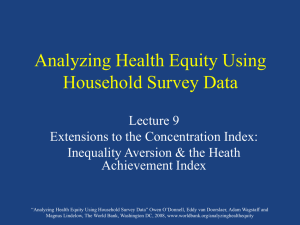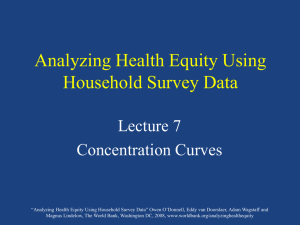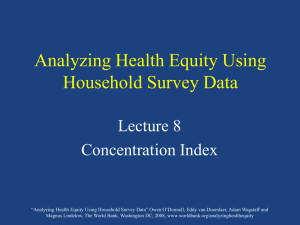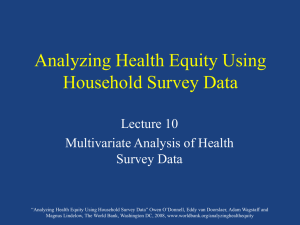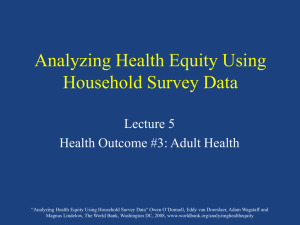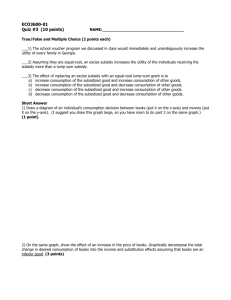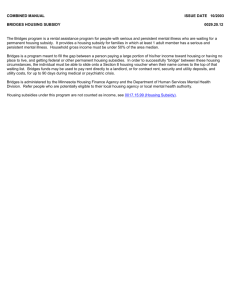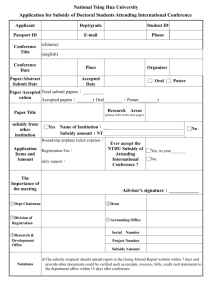Who Benefits from Health Sector Subsidies?
advertisement
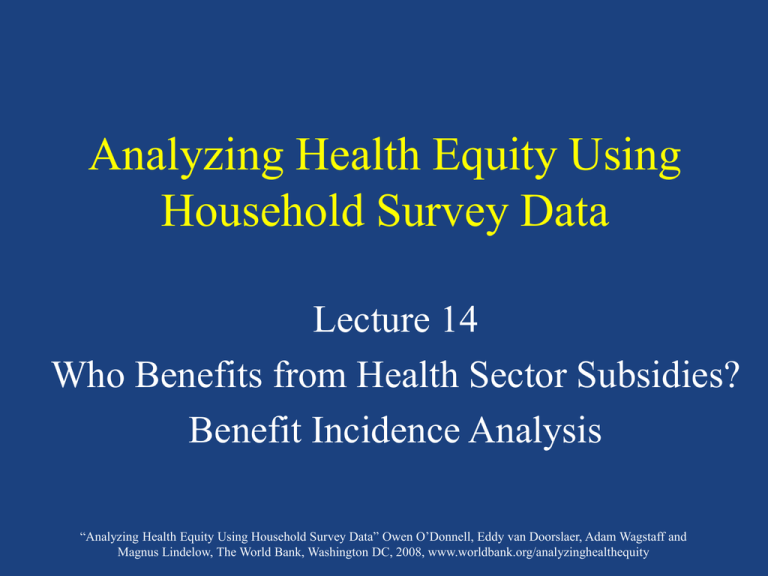
Analyzing Health Equity Using Household Survey Data Lecture 14 Who Benefits from Health Sector Subsidies? Benefit Incidence Analysis “Analyzing Health Equity Using Household Survey Data” Owen O’Donnell, Eddy van Doorslaer, Adam Wagstaff and Magnus Lindelow, The World Bank, Washington DC, 2008, www.worldbank.org/analyzinghealthequity Pro-poor public spending on health care • is an important objective of governments and international agencies. • This may derive from distributional concerns and/or from human capital/economic growth strategy. • So, are public subsidies targeted on the poor? “Analyzing Health Equity Using Household Survey Data” Owen O’Donnell, Eddy van Doorslaer, Adam Wagstaff and Magnus Lindelow, The World Bank, Washington DC, 2008, www.worldbank.org/analyzinghealthequity Which benefit incidence analysis? • BIA describes distribution of public spending, e.g. on health care, across population ordered by living standards or other socioeconomic /geographic characteristic. • Simple BIA determines who receives how much of public spending $. • Behavioral BIA seeks to establish extent to which public spending changes the distribution of income. – Requires estimating behavioral responses e.g. crowd-out of private health care • Marginal BIA seeks to establish who gains from marginal increases in public spending. • Here confine attention to distribution of average spending and abstract from behavioral responses. “Analyzing Health Equity Using Household Survey Data” Owen O’Donnell, Eddy van Doorslaer, Adam Wagstaff and Magnus Lindelow, The World Bank, Washington DC, 2008, www.worldbank.org/analyzinghealthequity Measure of living standards • Here we focus on the distribution of public health care in relation to living standards and not location, ethnicity, gender, etc • Any measure of living standards discussed in lecture 6 could be used • If use ordinal measure, e.g. wealth index, then can only determine whether distribution is pro-poor, or pro-rich • With a cardinal measure, e.g. income, can establish extent to which public spending is propoor “Analyzing Health Equity Using Household Survey Data” Owen O’Donnell, Eddy van Doorslaer, Adam Wagstaff and Magnus Lindelow, The World Bank, Washington DC, 2008, www.worldbank.org/analyzinghealthequity Three steps of BIA 1. Estimate distribution of utilisation of public health services in relation to measure of living standards 2. Weight units of utilisation by value of subsidy and aggregate across health services 3. Evaluate by comparing the distribution of subsidies with some target distribution “Analyzing Health Equity Using Household Survey Data” Owen O’Donnell, Eddy van Doorslaer, Adam Wagstaff and Magnus Lindelow, The World Bank, Washington DC, 2008, www.worldbank.org/analyzinghealthequity Data for estimating the distribution of public health care utilisation should • Be at household level from health /socioeconomic survey • Give health care utilisation and living standards measure for same observations • Distinguish between use of public and private care (only interested in former) • Distinguish (at least) between: – Hospital inpatient care – Hospital outpatient care – Non-hospital care (visits to doctor, health centre, polyclinic, antenatal) • Vary recall periods with frequency of use of service “Analyzing Health Equity Using Household Survey Data” Owen O’Donnell, Eddy van Doorslaer, Adam Wagstaff and Magnus Lindelow, The World Bank, Washington DC, 2008, www.worldbank.org/analyzinghealthequity Distribution of Public Health Care Utilization in Vietnam, 1998 Cumulative shares poorest 20% Hospital care Outpatient Inpatient visits days 8.90% 10.29% Commune Health Centre visits 22.65% Polyclinic visits 22.91% Other public health services 13.22% (standard error) (0.9949) (1.2141) (1.8860) (5.7815) (2.9644) poorest 40% 23.45% 27.74% 47.83% 32.81% 47.09% (1.6629) (2.0465) (2.4084) (6.2628) (6.3806) 43.58% 47.66% 77.86% 59.29% 59.00% (2.3987) (2.4772) (1.9943) (6.8524) (6.0599) 66.07% 70.36% 90.60% 78.24% 79.63% (2.7376) (2.5702) (1.4456) (6.5783) (4.5689) poorest 60% poorest 80% test of dominance against 45o line Concentration index - - + 0.2436 0.1784 -0.1567 0.0401 0.0056 (robust standard error) (0.0368) (0.0370) (0.0335) (0.1042) (0.0777) “Analyzing Health Equity Using Household Survey Data” Owen O’Donnell, Eddy van Doorslaer, Adam Wagstaff and Magnus Lindelow, The World Bank, Washington DC, 2008, www.worldbank.org/analyzinghealthequity The poor’s share of public health care in Asia (Equitap) Figure 2a: Poorest quintiles' shares of public health care utilisation and total consumption 50% 40% 30% household consumption hospital inpatient care hospital outpatient care 20% non-hospital care 10% H G Ban ei a g lo ns la ng u de jia (C sh ng hi n H (Ch a) on in g a) K on g In Ind do ia M nes al i a ay s N ia Sr ep i L al Th ank ai a V land ie tn am 0% “Analyzing Health Equity Using Household Survey Data” Owen O’Donnell, Eddy van Doorslaer, Adam Wagstaff and Magnus Lindelow, The World Bank, Washington DC, 2008, www.worldbank.org/analyzinghealthequity Computation of the public health subsidy • Value utilisation to allow for variation in subsidy across services, facilities, regions and individuals, and to aggregate across services • Service-specific subsidy received by individual (i) Ski qki ckj f ki where qki is utilisation of service k, ckj is the unit cost of k in region j where i resides and f is the fee paid. • Total subsidy to individual: S S ki i k ki k where k adjust for differences in recall periods “Analyzing Health Equity Using Household Survey Data” Owen O’Donnell, Eddy van Doorslaer, Adam Wagstaff and Magnus Lindelow, The World Bank, Washington DC, 2008, www.worldbank.org/analyzinghealthequity Calculation of unit costs • Units costs derived from total public recurrent expenditure on health care • Disaggregate this down to geographic region, then to facility (hospital, health centre etc.), then by service (inpatient, outpatient, etc) • Ideally National Health Accounts are available to do this • If accounts data do not allow disaggregation by region and facility, all units of a given service must be weighted equally. Then aggregation across services is only purpose served by application of unit subsidies. • Service specific cost data can be difficult to obtain given joint use of many health care resources. Facility-level cost surveys can be useful. Taking account of user fees • Simplest method - divide aggregate official user fee revenue by estimate of total utilization and assign average to all users • If net public expenditure available by regionfacility-service, then get variation in fee payments at that level • If survey provides data on payments, then can have individual variation in fees • If survey only gives amount paid for all services, then compute subsidy to indv. by si k qki ckj fi k “Analyzing Health Equity Using Household Survey Data” Owen O’Donnell, Eddy van Doorslaer, Adam Wagstaff and Magnus Lindelow, The World Bank, Washington DC, 2008, www.worldbank.org/analyzinghealthequity Discrepancies between reported and official user fees • can be substantial and due to revenue being kept locally either officially or unofficially • Appropriate treatment of user fees then depends on objective: • If to identify distribution of central govt. net expenditure, then payments in excess of official revenue can be ignored • But if seek distribution of net benefits, then payments made by indv. are relevant irrespective of whether official • If payments made to finance costs not covered by govt. budget, then cancel out from net benefit calculation • If payments are rent to providers, then should be subtracted in net benefit calculation In practice • survey data do not identify whether payments are centrally remitted, or if are rent extraction • Can estimate the distribution of official payments by scaling all payments by a constant equal to ratio of official to reported user fee revenue • Can test sensitivity of estimated subsidy distribution to this scaling of payments as opposed to subtracting all reported fees “Analyzing Health Equity Using Household Survey Data” Owen O’Donnell, Eddy van Doorslaer, Adam Wagstaff and Magnus Lindelow, The World Bank, Washington DC, 2008, www.worldbank.org/analyzinghealthequity Public Health Expenditure, Unit Costs and Subsidies, Vietnam 1998 Recurrent Total public exp. D million 2704424 utilisation '000s D 52779 (days) 35388 (visits) 43520 (visits) 3973 (visits) 49320 2865 6183 8572 Hospital care Inpatient Outpatient Comm. Health Centres 269101 Regional ployclinics 34062 Total Allocated 3007587 Notes: D a. b. Unit cost Total user fees Mean unit subsidy Official Reported D m. D m. 429128 2464000 1154000 48762 7152 17039 436280 3634960 Scaled user fees Reported user fees D D a 42988 1990 6183 7916 b 23800 1690 5393 6402 Dong Calculated from user fees reported in VLSS scaled to sum to official user fee revenue. Calculated from actual user fees reported in VLSS (not scaled). Source: Authors' calculations from World Bank (2001) and VLSS. “Analyzing Health Equity Using Household Survey Data” Owen O’Donnell, Eddy van Doorslaer, Adam Wagstaff and Magnus Lindelow, The World Bank, Washington DC, 2008, www.worldbank.org/analyzinghealthequity Evaluation of public health subsidy distribution against a target • implies choice of an objective. • Is subsidy pro-poor? – Compare subsidy shares with population shares check dominance of concentration curve against 45o – Summarise by concentration index; positive if prorich, negative if pro-poor. • Does the subsidy reduce inequality? – Compare subsidy shares with income shares – check dominance of concentration curve against Lorenz curve – Summarise by Kakwani index (CI – Gini); positive if inequality-increasing, negative if inequality reducing “Analyzing Health Equity Using Household Survey Data” Owen O’Donnell, Eddy van Doorslaer, Adam Wagstaff and Magnus Lindelow, The World Bank, Washington DC, 2008, www.worldbank.org/analyzinghealthequity Distribution of public health subsidies in Vietnam, 1998 Equivalent household consumption Outpatient poorest 20% 8.78% (standard error) (0.0429) Cumulative shares poorest 40% poorest 60% poorest 80% Hospital care Polyclinic Inpatient Commune Health Centre Other public health services 10.21% 10.98% 22.65%* 23.18%* 13.22% 12.29%* 14.81%* (1.3456) (1.3099) (1.886) (5.9155) (2.9644) (1.1219) (1.5426) 21.38% 24.75% 29.44% (0.0880) (2.1043) (2.1703) 37.19% 45.50%* (0.1360) (3.0206) * * 47.83% * * Total subsidy Scaled user Reported user fees fees 31.87% * 37.70%* 33.48% 47.09% (2.4084) (6.3918) (6.3806) (1.8559) (2.4110) 50.12%* 77.86%* 59.88%* 59.00%* 53.11%* 60.43%* (2.5461) (1.9943) (6.8763) (6.0599) (2.1498) (2.5184) 73.02% * 58.17% 67.65% 90.60% (0.1793) (3.2196) (2.5157) (1.4456) - + + + * 78.52% * (6.6011) 79.63% * 74.88% * 81.25%* (4.5689) (2.1076) (2.0504) + + + + test of dominance - against 45o line - against Lorenz curve Concentration Indexa (robust standard error) Kakwani Index (robust standard error) 0.3229 0.2160 0.1444 -0.1567 0.0298 0.0056 0.1106 0.0115 (0.0083) (0.0450) (0.0378) (0.0335) (0.1035) (0.0777) (0.0319) (0.0343) -0.1069 -0.1785 -0.4797 -0.2932 -0.3174 -0.2124 -0.3115 (0.0506) (0.0427) (0.0376) (0.1031) (0.0792) (0.0365) (0.0379) 0.0213 0.8688 0.1010 0.0088 Subsidy shares (scaled user fees) 1.0000 “Analyzing Health Equity Using Household Survey Data” Owen O’Donnell, Eddy van Doorslaer, Adam Wagstaff and Magnus Lindelow, The World Bank, Washington DC, 2008, www.worldbank.org/analyzinghealthequity 0 .2 .4 .6 .8 1 Concentration curves for health sector subsidies in Vietnam, 1998 0 .2 .4 population proportion .6 Cumulative Lorenz(y) outpatient total subsidy .8 inpatient health centre 45 degree line 1 Poor’s share of public health subsidy in Asia Poorest quintiles' shares public health subsidy 50% household expenditure public health subsidy 40% 30% 20% 10% G H B an g la an de sh s ei lo u (C ng jia hin ng a ) (C h H on ina ) g K on g In d In ia do ne s M ia al ay si a N ep Sr al iL an k Th a ai la n V d ie tn am 0% Rich’s share of public health subsidy in Asia Richest quintiles' shares public health subsidy household expenditure public health subsidy 50% 40% 30% 20% 10% H G B an g la an de s s h ei lo u (C ng jia hin ng a ) (C h H on ina) g K on g In d In ia do ne s M ia al ay si a N ep Sr al iL an k Th a ai la n V d ie tn am 0% “Analyzing Health Equity Using Household Survey Data” Owen O’Donnell, Eddy van Doorslaer, Adam Wagstaff and Magnus Lindelow, The World Bank, Washington DC, 2008, www.worldbank.org/analyzinghealthequity With a few exceptions, public health subsidies in Asia are pro-rich but inequality-reducing Table 4: Tests of Dominance of Concentration Curves for Public Health Service Utilisation and Subsidy Relative to Lorenz Curve and 45-Degree Line Utilisation Subsidy Hospital inpatient Hospital outpatient Non-Hospital O O O Lorenz 45 Lorenz 45 Lorenz 45 Bangladesh Gansu (China) Heilongjiang (China) Hong Kong SAR India Indonesia Malaysia a Nepal Sri Lanka Thailand Vietnam Notes: + + + + + + + + + - - + + + + + x + N/A + + + N/A + x - + N/A N/A + + + + + + + + N/A N/A + + + + + + Hospital inpatient Hospital outpatient Non-Hospital O O O Lorenz 45 Lorenz 45 Lorenz 45 + + + + + + + + + - - + + + + + + N/A + + + + N/A + - + N/A N/A + + + + x N/A + + N/A N/A + + + + N/A + + Total O Lorenz 45 + + + + + + x + + + + indicates the health care utlisation/subsidy is more concentrated on the poor than o household consumption per equivalent adult (Lorenz) or an equal per capita distribution (45 ) at 5% significance level. - indicates the health care utlisation/subsidy is less concentrated on the poor than o household consumption per equivalent adult (Lorenz) or an equal per capita distribution (45 ) x indicates that the curves cross and blank that there is no statistically significant difference a - The Equity results inUsing the hospital inpatient columns referOwen to bothO’Donnell, inpatient andEddy outpatient. “Analyzing Health Household Survey Data” van Doorslaer, Adam Wagstaff and N/A not available Magnus Lindelow, The World Bank, Washington DC, 2008, www.worldbank.org/analyzinghealthequity + + + - Public health subsidy is generally pro-rich in Asia Figure 4a: Concentration indices of public health subsidy 0.5 0.4 0.3 0.2 0.1 0 hospital inpatient -0.1 hospital outpatient -0.2 am V ie tn ka ai la nd Th iL an Sr N ep a di In H ei lo In u gl ad G an s Ba n l total subsidy a do ne sia M al ay sia -0.4 (C hi ng na jia ) ng (C hi na H ) on g K on g non-hospital care es h -0.3 “Analyzing Health Equity Using Household Survey Data” Owen O’Donnell, Eddy van Doorslaer, Adam Wagstaff and Magnus Lindelow, The World Bank, Washington DC, 2008, www.worldbank.org/analyzinghealthequity But inequality-reducing B an gl ad e G an sh su (C H h ei lo ina ) ng ji H on a ng g (C K hi on In na g di ) a In do ne si a M al ay s N ia ep al Sr iL an Th ka ai la nd V ie tn am Figure 4b: Kakwani indices of public health subsidy 0.1 0 -0.1 -0.2 -0.3 -0.4 -0.5 hospital inpatient hospital outpatient -0.6 non-hospital care -0.7 total subsidy “Analyzing Health Equity Using Household Survey Data” Owen O’Donnell, Eddy van Doorslaer, Adam Wagstaff and Magnus Lindelow, The World Bank, Washington DC, 2008, www.worldbank.org/analyzinghealthequity In general, non-hospital care is more pro-poor than hospital and outpatient less pro-rich than inpatient Table 7: Tests of Dominance between Concentration Curves for different Public Health Services Hospital inpatient vs outpatient Bangladesh Gansu (China) Heilongjiang (China) Hong Kong SAR India Indonesia Malaysia a Nepal Sri Lanka Thailand Vietnam Notes: op>ip op>ip op>ip op>ip op>ip Utilisation Hospital inpatient vs non-hospital N/A N/A Hospital outpatient vs non-hospital Subsidy Hospital inpatient Hospital inpatient vs outpatient vs non-hospital N/A N/A non-h>ip non-h>op non-h>ip non-h>op non-h>ip non-h>op non-h>(ip+op) op>non-h non-h>ip non-h>op non-h>ip non-h>op op>ip op>ip Hospital outpatient vs non-hospital N/A N/A ip>non-h non-h>ip non-h>ip non-h>ip non-h>op non-h>op non-h>op N/A non-h>ip non-h>ip N/A non-h>op non-h>op N/A N/A ip - inpatient, op - outpatient, non-h - non-hospital > indicates dominance e.g. op>ip indicates outpatient services are more concentrated on the poor than inpatient. Blank indicates that the null of non-dominance is not rejected at 5% significance level. N/A - not available. a. Test is between all hospital care (inpatient and outpatient) and all non-hospital care. “Analyzing Health Equity Using Household Survey Data” Owen O’Donnell, Eddy van Doorslaer, Adam Wagstaff and Magnus Lindelow, The World Bank, Washington DC, 2008, www.worldbank.org/analyzinghealthequity Cross-country differences in the distribution of the public health subsidy in Asia “Analyzing Health Equity Using Household Survey Data” Owen O’Donnell, Eddy van Doorslaer, Adam Wagstaff and Magnus Lindelow, The World Bank, Washington DC, 2008, www.worldbank.org/analyzinghealthequity Summary of findings from Equitap BIA • • • • • Subsidy strongly pro-poor in Hong Kong – Universal system with modest user charges and exemptions for poor – Private sector alternative allows better-off to opt out Among low/middle income countries, subsidy is slightly pro-poor in Malaysia & Thailand, neutral in Sri Lanka, slightly pro-rich in Vietnam and very pro-rich elsewhere. Pro-rich bias stronger for inpatient than outpatient hospital care. Non-hospital care is usually pro-poor. But greatest share of subsidy goes to hospital care and this dominates distribution of total subsidy. “Analyzing Health Equity Using Household Survey Data” Owen O’Donnell, Eddy van Doorslaer, Adam Wagstaff and Magnus Lindelow, The World Bank, Washington DC, 2008, www.worldbank.org/analyzinghealthequity Is this good news or bad news? • Findings strengthen evidence base showing health subsidies are not pro-poor in developing countries. • If aim is to ensure poor get most of public health services, then failing. • But Malaysia, Thailand and Sri Lanka are exceptions. • If is part of wider policy to reduce relative differences in living standards, then succeeding. “Analyzing Health Equity Using Household Survey Data” Owen O’Donnell, Eddy van Doorslaer, Adam Wagstaff and Magnus Lindelow, The World Bank, Washington DC, 2008, www.worldbank.org/analyzinghealthequity
